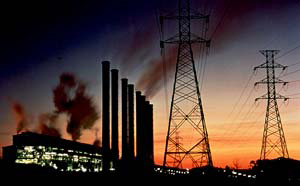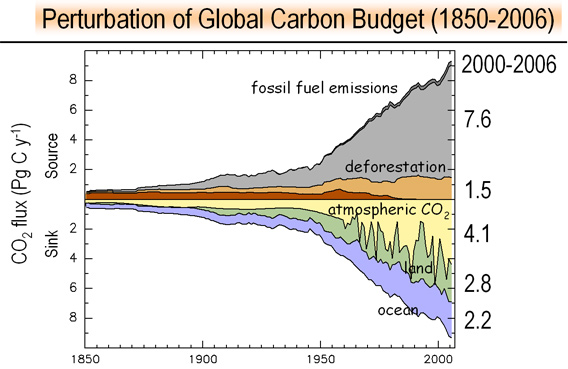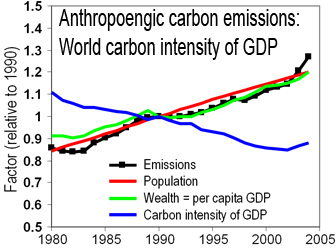Carbon sinks failing to keep up with emissions
Carbon sinks failing to keep up with emissions
mongabay.com
October 22, 2007
Atmospheric carbon dioxide (CO2) growth has increased 35 percent faster than expected since 2000, report scientists writing in Proceedings of the National Academy of Sciences. Worryingly, more than half the increase came from a decreased efficiency of natural land and ocean sinks to absorb CO2 from the atmosphere. The reminder came from a slowing in the efficiency of use of fossil fuels.
The research, which was conduced by the Global Carbon Project, the University of East Anglia (UEA), the British Antarctic Survey (BAS), and a number of other institutions, reported that global CO2 emissions were around 9.9 billion tons of carbon in 2006, or 35 percent above emissions in 1990, the year used as a reference year under the Kyoto Protocol. Atmospheric carbon dioxide levels climbed an average of 1.93 parts per million (ppm) between 2000 and 2006 compared with an annual growth rate of 1.58 during the 1980s and 1.49 ppm in the 1990s. Annual emissions from the burning of fossil fuels — the largest source of anthropogenic carbon — increased from 6.5 billion tons in the 1990s to 7.6 billion tons between 2000 and 2006. Emission from deforestation and other land-use change were 1.5 billion tons in 2006, or around 15 percent of total anthropogenic emissions.
Saturated carbon sinks
 A power station in Australia. Credit CSIRO |
The researchers say that climate-induced shifts in wind patterns over the Southern Ocean have brought carbon-rich water toward the surface, reducing the ocean’s ability to absorb excess carbon dioxide from the atmosphere. On land, extensive droughts have reduced the uptake of carbon by plants.
“Weakening land and ocean sinks are contributing to the accelerating growth of atmospheric CO2,” said co-author Chris Field, director of the Carnegie Institution’s Department of Global Ecology.
“The decline in global sink efficiency suggests that stabilization of atmospheric CO2 is even more difficult to achieve than previously thought,” explained co-author Dr Corinne Le Quéré of the University of East Anglia and British Antarctic Survey. “We found that nearly half of the decline in the efficiency of the ocean CO2 sink is due to the intensification of the winds in the Southern Ocean.”
 Global carbon sinks and sources 1850-2006. Courtesy of the Global Carbon Project. |
Carbon efficiency of economic growth declines
 Anthropogenic carbon emissions: World carbon intensity of GDP. Courtesy of the Global Carbon Project |
The research also showed that improvements in the carbon intensity of the global economy have faltered since 2000 after improving by about 1.3 percent per year for prior 30 years.
“Because practically all proposed scenarios for managing future emissions postulate improvements in carbon intensity in the global economy, this deterioration of carbon intensity presents a serious challenge in stabilizing atmospheric carbon dioxide and mitigating climate change,” warned the Carnegie Institution in a statement.
“What we are seeing is a decrease in the planet’s ability to absorb carbon emissions due to human activity,” said the study’s lead author, Dr Pep Canadell, executive director of the Global Carbon Project. “Fifty years ago, for every tonne of CO2 emitted, 600kg were removed by land and ocean sinks. However, in 2006, only 550kg were removed per tonne and that amount is falling.”
“The longer we delay reducing emissions, the more restorative capacity will be lost,” added CSIRO scientist Dr Mike Raupach, a co-chair of the Global Carbon Project.
CITATION: Josep G. Canadell, Corinne Le Quere, Michael R. Raupach, Christopher B. Field, Erik T. Buitenhuis, Philippe Ciais, Thomas J. Conway, Nathan P. Gillett, R. A. Houghton, and Gregg Marland (2007). Contributions to accelerating atmospheric CO2 growth from economic activity, carbon intensity, and efficiency of natural sinks. Proceedings of the National Academy of Sciences , October 2007.